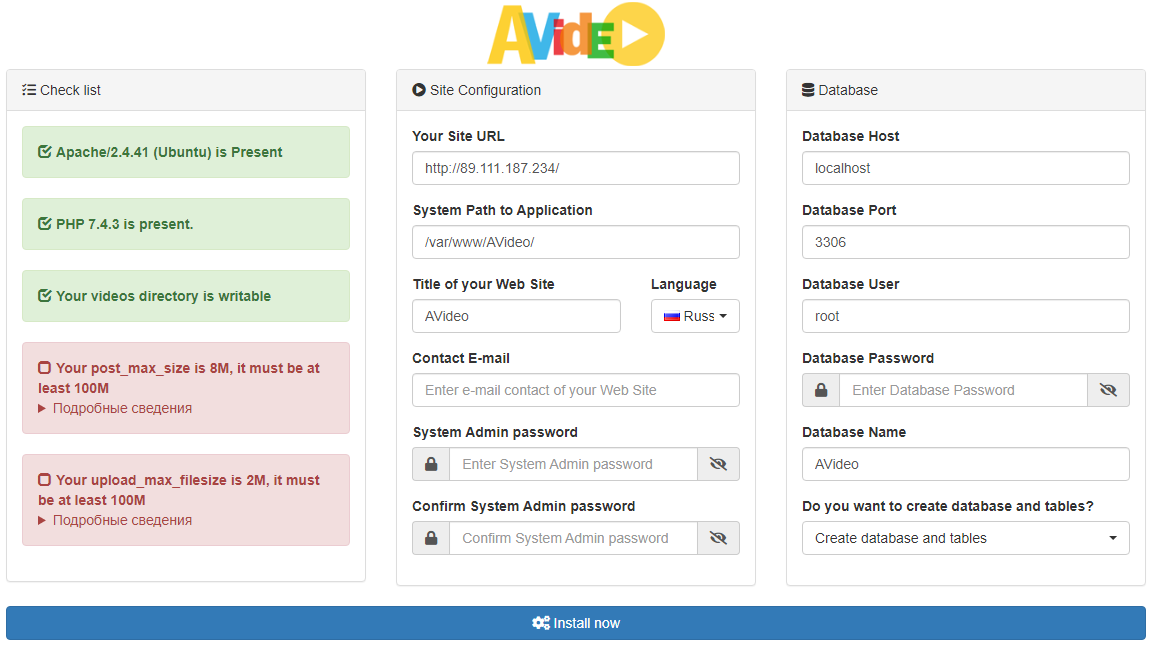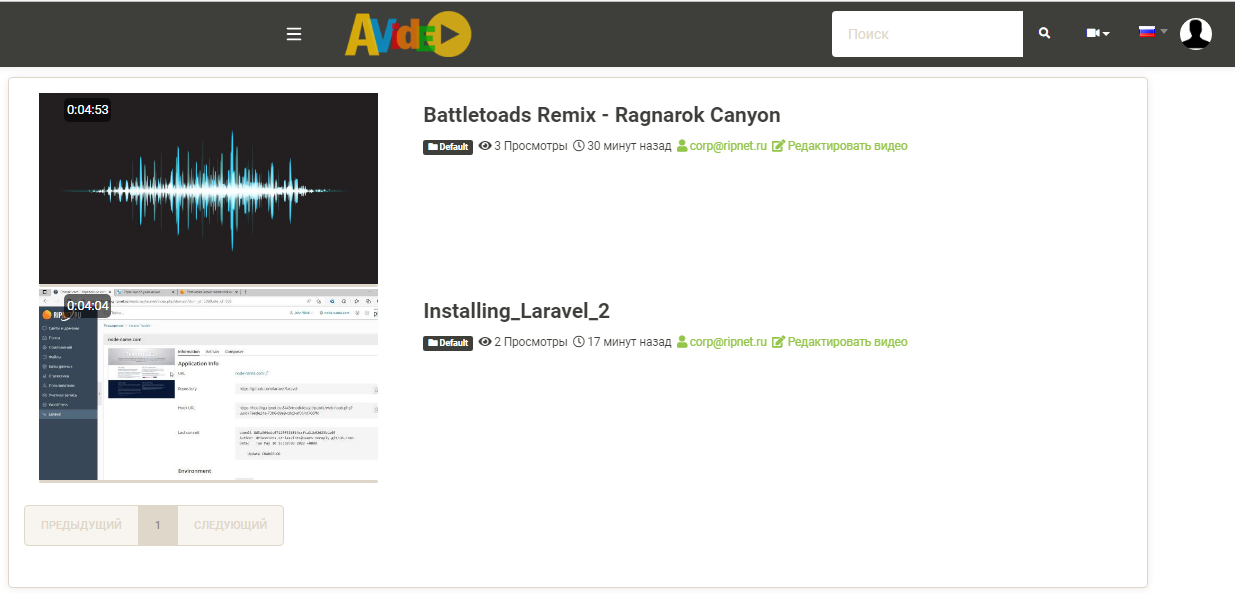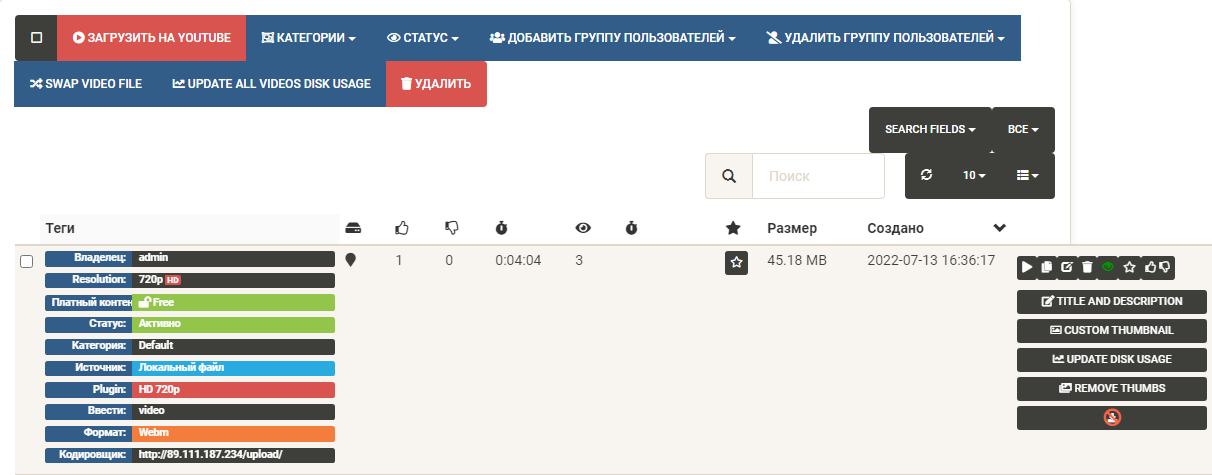
AVideo/YouphpTubeのインストールは、LinuxのSSHコンソールを使用して数コマンドで行います。例として、LAMPが事前に設定されたUbuntu 20.04を使用しました。すべての操作はrootユーザーで実行されました。
1.1. アプリケーションのダウンロードとインストール:
cd /var/www/
apt install git
git clone https://github.com/WWBN/AVideo.git
cd AVideo/
git clone https://github.com/WWBN/AVideo-Encoder.git
mv AVideo-Encoder upload
chown www-data:www-data /var/www/AVideo/ -R
apt install ffmpeg
apt install libimage-exiftool-perl
apt install php7.4-cli php7.4-common php7.4-json php7.4-opcache php7.4-readline php7.4-curl php7.4-gd php7.4-xml
apt install python3-pip
pip3 install youtube-dl
1.2. cronにタスクを追加しましょう:
crontab -e
@daily sudo -H pip3 install --upgrade youtube-dl > /dev/null
ファイルの末尾にタスクを追加します。
1.3. データインポート用のデータベースを準備します:
mysql
create database AVideo;
create user AVideo@localhost identified by 'your-password';
grant all privileges on AVideo.* to AVideo@localhost;
create database AVideoEncoder;
create user AVideoEncoder@localhost identified by 'your-password';
grant all privileges on AVideoEncoder.* to AVideoEncoder@localhost;
flush privileges;
exit;
1.4. ウェブサーバーの準備、ここではApache FPMを使用します
nano /etc/apache2/sites-available/avideo.conf
ServerName your-site.com
DocumentRoot /var/www/AVideo
DirectoryIndex index.php
Options +FollowSymLinks
AllowOverride All
Require all granted
ErrorLog ${APACHE_LOG_DIR}/avideo.error.log
CustomLog ${APACHE_LOG_DIR}/avideo.access.log combined
ドメインを自分のものに変更し、もしドメインがない場合は、localhostに置き換えてファイルを保存します。
作成した設定を有効化します:
a2ensite avideo.conf
a2enmod rewrite
systemctl restart apache2
a2dissite 000-default.conf
1.5. ブラウザでインストールを続行します http://your-server-ip/

赤で表示されている警告を修正します:
nano /etc/php/7.4/apache2/php.ini
nano /etc/php/7.4/fpm/php.ini
ファイル内の行を探します:
post_max_size = 8M
upload_max_filesize = 2M
以下の値に置き換えます:
post_max_size = 1024M
upload_max_filesize = 1024M
次にサービスを再起動します:
systemctl restart apache2
systemctl restart php7.4-fpm
1.6. データベースのユーザー、データベース名、データベースパスワードに、データベース作成時に指定した情報を入力します:
Database User = AVideo
Database Name = AVideo
Database Password = your-password
インストールが成功したら、インストールフォルダを削除します:
rm /var/www/AVideo/install/ -r
2. ビデオデコーダのインストール、この例では、同じサーバーにインストールしますが、大量のビデオをアップロードする場合は、別のサーバーを使用することをお勧めします。工業規模では、最初のサーバーはデコードされたビデオの視聴および保存用に使用され、2番目はファイルの変換用に使用されます。デコードはCPUリソースを多く消費するため、通常は別々のサーバーに分散されます。
リンクを開いて http://your-server-ip/upload、デフォルトのphp値を修正します:
nano /etc/php/7.4/apache2/php.ini
nano /etc/php/7.4/fpm/php.ini
オプションを探します:
max_execution_time = 30
memory_limit = 128M
これらに変更します:
max_execution_time = 7200
memory_limit = 512M
設定を適用し、サービスを再起動します:
systemctl restart apache2
systemctl restart php7.4-fpm
2.1 ページをリフレッシュし、2つ目のデータベース用のデータを入力します:
Database User = AVideoEncoder
Database Name = AVideoEncoder
Database Password = your-password
その他のパラメータも入力します
Allowed Avideo Sreamers Sites = http://your-server-ip/
AVideo Streamer Site URL = http://your-server-ip/
AVideo Streamer Site admin = admin
AVideo Streamer Site admin = ステップ1.5で作成した管理者ユーザのパスワード
インストール後、セキュリティ上の理由でディレクトリを削除します
rm /var/www/AVideo/upload/install/ -r
3. メインURLで設定に移動します http://your-server-ip/
管理メニューで、設定 -> サイト設定 -> 追加設定に進みます。エンコーダのURLをhttp://your-server-ip/upload/に変更します。設定を保存し、キャッシュディレクトリをクリアし、新しいサイトマップを作成します。
ログアウトして再度ログインします。右上のビデオとオーディオのエンコードボタンをクリックすると、自分のエンコーダに移動してビデオをダウンロードできます。エンコード速度はサーバーのCPUパワーに依存します。RAMはあまり必要ありません。なぜなら、エンコーダがビデオを一時ファイルとしてアップロードディレクトリ(/var/www/AVideo/upload/videos)にコピーするからです。
テストファイルのダウンロード後、メインページは次のようになります:

管理メニュー

これで基本的なインストールと設定が完了しました。ビデオとオーディオファイルが正常にエンコードされ、視聴可能になります。このCMSには、Youtubeからのビデオのインポートやエクスポートを含む、多数の設定と機能があります。

